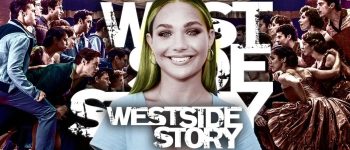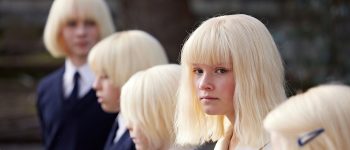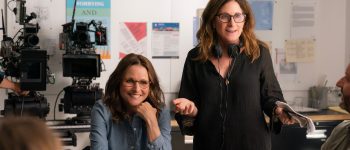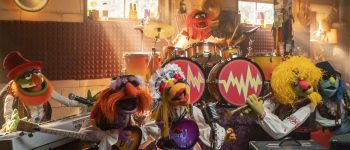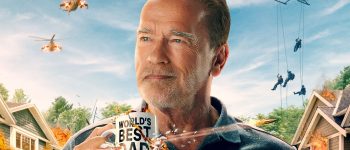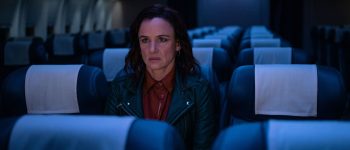If you missed out on Collider’s screening for Prime Video’s The Lord of the Rings: The Rings of Power and cast and crew Q&A, or even if you want to relive the magic of seeing it all up on the big screen, read on! From giving life to the Second Age of Middle-earth to the unique challenges faced by the actors of embodying J.R.R. Tolkien’s different fantastical races, Editor-in-Chief Steve Weintraub spoke with Morfydd Clark (Galadriel), Ismael Cruz Córdova (Arondir), Owain Arthur (Prince Durin IV), Sophia Nomvete (Princess Disa), costume designer, Kate Hawley, and the director of Episodes 1 and 2, J.A. Bayona.
- ‘Fatal Attraction’ Season 1: Yes, Toby Huss, Reno Wilson & Brian Goodman Were Also Shocked at That Killer Reveal
- These ‘Love Island USA’ S5 Couples Didn’t Take Home the Grand Prize, But They Went Home Winners in Love [Interview]
- ‘Yellowjackets’ Season 2 Finale: Courtney Eaton on Filming the Plane Scene
- ‘Transformers: Rise of the Beasts’ Anthony Ramos & Dominique Fishback Talk Filming on Machu Picchu in Peru
- Courtney Eaton Defends Lottie: “Lottie Does Everything from the Best Place”
The castmembers discuss what it was like filming such an iconic series, becoming a part of a culture phenomenon, and finding their characters through the vision of the creators behind this never-before-seen Second Age. They share anecdotes from set, like what it’s like having a Balrog in the basement, and the deeper impact of providing representation across Middle-earth, inspired by the texts and art that Tolkien created and evoked. Whether you’re a fan of the books, Peter Jackson’s films, all of the above, or are new to the world of Tolkien, the heart and passion for the material by both cast and creatives is awe-inspiring. To learn about all of this and so much more, you can watch in the video below, or read along in the full transcript while we wait for Season 2!
COLLIDER: I have a million questions, I want to start with the cast. If you have a choice between spending the day doing promotional photos or being covered in the crud and dirt that you were covered in in Episode 7, I believe when Mordor explodes, what do you choose? Is it the promotional photo day or is it filming covered in dirt and crud?
MORFYDD CLARK: I actually loved the dirt and grime. And also, I got really obsessed with what it was made of, and it’s made of potato, which I was really surprised at, really ingenious. And the people who are doing the breakdown, they’re like, “I put an extra bit of potato starch in this, and it’s really sticking!” And I kind of love seeing them get super excited about particular textures they’re creating. But it wasn’t nice when it went in your eyes, opening my eye for that bit was pretty brutal.
ISMAEL CRUZ CÓRDOVA: Without the crud, there’s no promotional photos to take. I think what’s so special about our show is that even that is full of artistry, even the way when we’re fully covered in mud and all those things, it’s just completely to the last detail. So for us as actors, and I know that we all feel the same way, inhabiting these characters in a show that is so fully– people are obsessed over making it real and having Tolkien come to life, but also make it a 2020, 2022, 2023, 2024 [laughs]– for new audiences. It is an honor to even be covered in mud. Almost.
OWAIN ARTHUR: For me, it is a tough call actually. It’s a very good question. I mean, our gorgeous costume designer is here, so I will have to say being on set.
KATE HAWLEY: Are you saying I’m a crud-maker?
ARTHUR: No, I’m saying the costume is! I jest. No, I’m all in for the dust and the dirt, personally.
SOPHIA NOMVETE: I haven’t had a chance to roll around in the dust and the dirt yet. Yeah, I hope for some. So, I’m gonna go with the photoshoots. They’re actually in a car park for us, isn’t it?
ARTHUR: Oh, they were.
NOMVETE: They’re in a car park. It all looks very flamboyant and mountainous, but actually, we’re in a car park at that point [laughs]. But they’re good fun, you get to kind of play and just embrace and enjoy the amazing visuals of your character. So yeah, they’re pretty cool.
Bringing the Second Age to Life
For the people on the end, one of the things that you guys both had to do is you had to bring the Second Age to life for the first time, and I’m curious for both of you, if you could talk a little bit about how you prepared for what you wanted it to look like, and the visual style. You were opening this series up and deciding on the visual look, and there was a lot that you guys both were responsible for the Second Age.
J.A. BAYONA: No, the truth is that because it was Second Age, there was not any example to follow, we had to create a world from scratch. So basically, we look at lots of references from art. I remember that we mentioned each world, each kingdom, had to be very particular and specific. I think one of the greatest things about working in a show like this one, a story like this one, is that everything tells a story, every color, every texture, the use of light tells a story. You can use the language of cinema – and I say cinema because, to me, it was like shooting a film – you can use the language of cinema to the maximum. I remember, we sat down and we talked about lots of references, [like] painters, for example, for the elves.
HAWLEY: Yeah, all of those were coming from direct references to Tolkien’s influences, as well as his writing. So we use that as a start, but it also came back to the knowledge that we had of the Third Age, where our characters end up. So we’re at the beginning of our arc, and rooting everything in the natural elements and all the cultures and races in their environments, and the natural elements of the world, and that was all coming from Tolkien. And we used the paintings to try and capture some of the poetry of the work and words, [to Bayona] and I think you did that beautifully.
BAYONA: Well, we had some funny references for the dwarves, I remember that. We saw Russian silent films from [Sergei] Eisenstein. There was a lot of [Andrei] Tarkovsky, weird things, you know?
HAWLEY: Looking back, we also looked at some of the Expressionist stuff, you know, [Die Nibelungen], and all Germanic mythology that Tolkien was interested in. The legend of King Arthur was another major point. So all of it came into this sort of melting pot and we distilled things. We had a thing called the war room, which was a secret little room behind many doors because a lot of these wonderful people would turn up and sometimes there wasn’t always a script to follow, so we created these environments with J.A., and everybody worked through the language. Each section pertained to a race and that, and we’d build all these, sort of like a mausoleum, of artifacts, really, that we created, and materials and things we would put there. you know, put there. So the Dwarven culture and the materials, what were they like in contrast to the Elven ones? And all of it had a similar language, but created a difference through the uniqueness of each culture.
ARTHUR: Can I just say, that room was phenomenal. It was our first glimpse into Middle-earth, and we’ve all heard of a mood board, right? This was a mood cave all full of how Kate’s brain works.
HAWLEY: Quite busy!
ARTHUR: Yes, it was a complete mess. Everything was on the floor, it was horrible. No, it was fantastic. It was incredible. And instantly when, as an actor, you walk into a project like this and you just see what you’re about to be in, it just inspired. I was inspired by it anyway.
CÓRDOVA: Yeah, and both of these brilliant artists were, for us, the first introduction to this job, as Kate said. In the early stages we did not have scripts. You know, they were what we worked on, and our introduction, heavily, was the imagery and the storyboarding, and the passion that J.A. would communicate to us. But also, we began building characters from Kate’s designs. We started building that character with her, but to be fair, they were essentially complete. She also always had an ear for us and there was a collaboration, and those costumes continued to evolve.
HAWLEY: It works both ways. It’s only part of the process, the discussions that the director and I would have, my response to the script, our response, you know, building the designs. But, it’s only the beginning of the journey, and that’s significant in the development with all of these wonderful actors to discover their character because it’s not complete until they bring their world and physicality to it. And on that note, when a Owain says he walked into our room, he didn’t, he pirouetted en pointe. [Laughs] That completely changed my vision of a Dwarf!
ARTHUR: So that’s why you gave me metal boots, to keep my feet on the ground.
I’m curious for the cast, what is a scene that you can’t believe you got on your first take, and which is a scene that you figured, “This is nothing,” and it took you all day?
NOMVETE: I’ll do one, which was the dinner scene with J.A., that I thought it was going to be quite simple, until you put food in front of me [laughs]. And at first, I saw J. pouncing at speed onto the set to say, “Sophia, there’s food in front of you, you’ve got to eat it.” So I was like, “Okay, okay, talk and eat, talk and eat, we can do it. Talk, talk, eat, move all at the same time, do the acting.” So I did that, and I was like, “This is gonna be fine. It’s gonna be easy. This is the one scene that we’ve rehearsed. We had the script, we didn’t shoot over a year later.” Myself, Owain, and [Robert Aramayo], who plays Elrond, were rehearsing in flats, having a great time. I was like, “This is gonna be a breeze!” Eating, eating, eating.
J.A. comes in pounding, I could hear the footsteps. I’m like, “Oh my goodness, what’s happening?” J.A. comes in, “Sophia, you’re eating too much. Please stop eating. All I can see is you chewing this lamb…” [Laughs] It’s really good food, though, actually! So yeah, that was the one moment in a scene that I felt took way longer than it should have done.
CLARK: Mine was when Galadriel is found by the people on the raft in the sea, and it was how I was dragged onto the boat. The first few times, Charlie Vickers had been working on that raft, so he was kind of feeling all like pumped up and stuff, and he pulled me up like this [gestures lifting something heavy], as if it was the hardest thing ever. And I was like, “Charlie, I’m going to be an Elf, I’m gonna be really light, like a little feather.”
And so, there was like lots of, Elf-wise, it was like, how do you make it look Elfie? And you’d have to kind of watch it back and see, and be like, “Oh, I didn’t know how human that was,” but it definitely is. Just the angle of everything. J.A. really gave us so much time to kind of explore this, and that was really invaluable.
CÓRDOVA: Mine is also in the vein of Elveness. One that I was very surprised that we got one take is… in Episode 3, when I jump and break that canopy situation, that’s the take, the one that we did. And that took months of preparing, but the resets are so intense, and also, I’m like a super-perfectionist, and you have to have 1000 considerations in the air, and whatnot. So that was it, I thought that was gonna take forever.
The one that I thought was gonna be more of a breeze was the scene by the well, Episode 1, I think you guys watched that. I mean, I had been auditioning with versions of that scene for almost two years, so I was like, “Oh, I got this in the pocket.” But, the aspect of Elveness, how to evoke those feelings through the structure of that being, of being essentially eternal, not being human, a being that feels differently, that has all this curiosity, that love and romance – our romantic love is coming from a completely different place – and still keep it stoic and distilled, and Elven. That was a challenge, and still at the end, I didn’t know what I’d done and I felt that it would have been terrible, and whatnot. But yeah, that challenge was through the season, how to live through the Elven being.
ARTHUR: I know that the rock-breaking competition took a while because we had, like, 50, 60 [supporting artists] there. I hadn’t realized that I would have to have shouted at Elrond and at the dwarves, and slam down on the rock so much. That took longer than I thought it would, but I’m so happy that it took that time because it looked incredible [laughs].
HAWLEY: And there was scale used…
ARTHUR: I mean, there are many scenes that you think, “Oh, it’s just a two-hander, it’s just me and Elrond, it’s gonna be easy.” Eh eh! That was a mistake.
BAYONA: Because on top of the complexity of these scenes, then you need to think about the complexity of the scale, that we were learning as we were doing it because those were the first episodes.
ARTHUR: Yeah, there were so many times where Robert Aramayo, who plays Elrond, was up on a platform, sometimes on a step ladder, sometimes a chair, sometimes he had the pack with a little stick coming [up]. It was like a vest with a piece of stick coming up the top, and his face up there. So you can imagine between takes, Rob’s walking around, kind of forgetting that he’s got this jacket on. It’s like he’s promoting himself, like, “Hey, I’m Rob!” [Laughs] That was an interesting version that we had to do is to kind act with the promotional Rob.
Those scenes took a while because when it then came on to Rob’s take, I would have to be down on the floor. So I would either be on the knees, or I remember one in particular where I was on a stool that had wheels, and because my character walks around in the scene, Rob’s eyeline needed to move around, as well, but I couldn’t take human steps, my steps, they had to be Dwarven steps, and therefore, the movement was shorter. So I was kind of just trying to slide around on this– that took longer than expected as well.
Everyone in this room, to be here on a Saturday and to be watching this, they’re a fan, and everyone who’s going to be watching the Q&A, which we’re filming, is a fan. So for fans, what do you think would surprise people to learn about the making of the show that they wouldn’t know?
HAWLEY: I do think we cared as much as every fan. None of us took this job on, or this project on rather than a job, we’re all passionate about the material and we’ve all had opportunities to see it and read the books. I think we all invested that and we were always thinking of that as part of the process, but also trying to find the language that worked for the age that we were in. I think it was always behind everything we did, the due diligence of bringing in, you know, within costumes we tried to bring in echoes of things, artifacts from Gondolin, and in the Dwarven world. We tried to bring everything we could to keep bringing depth to the storytelling, and things that weren’t always possible to show. So I think we cared. It was the biggest thing hanging over us in many ways.
ARTHUR: There are so many details on set, on the costumes, and on little artifacts that have so much detail and they are – what do they call them? Easter eggs? There’s loads of eggs in there that haven’t probably hit the screen yet. There’s just lots of stuff like that.
The one thing I will say, and it is negative, it’s the comfort of wearing a beard, and the costume, as beautiful as it is, it’s hard work, Kate!
CÓRDOVA: Watch it…
HAWLEY: It could have been harder.
ARTHUR: Yes, exactly [laughs]. I thought you liked me. No, you do.
CÓRDOVA: I wanted to expand, also, on what Kate was saying. I think the fans should know that we are also fans, and that we approached it with that heart. We were shooting this through COVID, and the personal sacrifice that came for us to be working on the show is something that, you know, it’s difficult to convey because we were all away from home. We were all essentially locked in an island for almost two years, and this was our life, and we made it our lives. And on set, rehearsal, but also our off days we would meet, we would talk about it. There were Zoom groups made out of our own accord – or other cast members’ accord because I was always kind of lost – to talk about Tolkien. How immersed we became in this with the fans in mind is something that I hope that you all know, and that the fans know that this was truly a labor of love and respect, and we just wanted to do right by you all.
BAYONA: Let me add– Because we are listening here, the actors, and laughing, and then we are listening to Kate, but it’s fascinating to listen to you. And as a director, you have the feeling that you have everything because you have the humanity here, and then you have all the knowledge and the talent of the costumes, so it was very easy to be on set and to be working. You need to imagine the level of challenge that we had in recreating the Second Age for the first time on the screen, but being surrounded by these guys here, and this woman here, made my work a lot easier.
Representation Across Middle-Earth
I’m curious for everyone, which was your favorite episode and why?
CLARK: I think mine is the first episode, for so many reasons, but I feel that when I first watched that, even though I was there on these sets that were so beautiful and I was wearing these costumes that I knew were stunning, actually watching what we made, nothing will compare to that first episode where I got to see that. But also, in terms of Galadriel, I love the scene with Galadriel and Elrond, just before she’s kind of sent to Valinor, when they’re speaking about what it feels like to be a living element of history. And just as a fan, that we were next to all those trees that had all these kind of Elves carved into it that we kind of recognized, I think that first episode will always hold just pure magic for me, and J.A., he created that for us. It was amazing.
NOMVETE: It’s such a tricky question. I think it’s gonna have to be Episode 2 because it was the beginning. As I said, that scene that we did had been played for a year by myself, Rob and Owain in a flat. That hug between Disa and Elrond was crafted in a hotel room on a dining room chair while Owain was cooking us chicken sandwiches. He was like, “Right, I’ll get up on this chair so that we can really see how it–” – that’s my bad northern accent – “So that we can really see how this hug is gonna go!” And it was hilarious, and it made it in the show because it came from such an authentic place of our friendship and our hilarity and our playing.
And I guess that episode for me, and particularly for us, was the beginning. It was the genesis of the Dwarves as we see them now, and actually, I think the first time that, obviously, we’ve ever seen them in this way, so alive, so kind of present, and with so much depth, and that was our foot in. That was our, “Okay, here we go. Here are the Dwarves. Here is Khazad-dûm, awake for the first time. And I think the beginning of that, and of course, to be led by this genius of a man, for me was unforgettable.
It was also my major TV debut, I’d done theater my whole entire life. So to step onto a screen – of which I kept on walking on by accident before they said action because in the theater world, if there’s silence, you get on, there’s a problem? You just walk on, and do something! [Laughs] So I think there’s a few moments of silence, so I just kept boldly walking on, and Rob was like, “[Whispers] You have to wait for action.” I was like, “Great, great, great, great on it, on it, on it, on it!” So, I think it was like my biggest learning, it was kind of where Disa really got to flex her muscles and say, “Okay, I’m here. I’ve arrived.” So I’ll never forget that.
CLARK: Also, genius bit of costuming of the Dwarven children in that.
NOMVETE: Ohh, yeah!
HAWLEY: That came from practical needs.
NOMVETE: [Laughs] Stopping them from crash, bang, walloping. “Come here, come here!” I was like, “They’re going to bump into each other!” But no, they were great, they were very cool.
ARTHUR: I think I knocked–
NOMVETE: One out?
ARTHUR: [Laughs] I think I did! Because I lifted him up, and he hit his head – well, he hit his helmet – into the lampshade! That was a mistake. I just didn’t know how tall I was.
I think my favorite is– yeah, I’ll second that. I’ve got two, can I say two? So [Episode] 2 and 7 are my favorites because 2 is the establisher for us, for our world, and the first time working with J.A. and I got to do everything, I got to be intimidating, I got to be a leader, a prince, a hero rock-breaker, an eater, a belcher, a husband, a friend.
NOMVETE: A loving husband.
ARTHUR: And then I get emotional with my best friend, so it’s like, I got the range. I was allowed to go through there. Being a Dwarf, as well, was such a gift, and to do it with J.A. playing “We Will Rock You” music over, and the scene was great. But 7 I hold quite close to my heart because it’s the payoff, really, or the heartache of the entire season for the Dwarves. Shooting that and exploring that, and kind of getting into the depths of it and then looking back and watching it back, and all the work that everyone had created, that’s a favorite as well. So, yeah, I’m choosing 2 and 7.
As long as you’re not saying Episodes 1 through 8, you know what I mean?
CÓRDOVA: I love every episode, especially the ones where I have more screen time. So those are my favorites.
see more : How ‘Past Lives’ Director Celine Song Got Complete Authorship on Her First Feature Film
NOMVETE: And he’s not lying, he’s not lying [laughs].
CÓRDOVA: Absolutely not. I mean, don’t you love that, though? Because, like, “Well, I love the episode where I’m there for 30 seconds,” said no actor ever. But we work with fantastic directors, each director had just magic and passion, but as I’m hearing the responses – and it’s not just because J.A. is here – we all had different stories of how we came to the show. I had this long audition process, and within the process I had several rejections to the role, and I kept fighting to be in the show, and I was kind of obsessed– not obsessed, but very committed and determined to be in the show, for what it represented. I’m sure you all know, I mean, the first Elf of color, and all these things, and the big representation aspect of it all. You know, we do it for the people. But it was such a journey, and it was such a personal journey that I feel I was preparing for this role for like 20 years, since I first saw the first movies. It was a personal desire of mine to be that Elf, despite all of the rejections along the way, those 20 years as well, because it happened to be laughable to some people. So there was so much riding on it, and I knew, later on, one of my champions behind the scenes was J.A., and I heard the stories. I heard that, later on, some people would be like, “No, he’s not right for the role,” and then maybe a few months later, J.A. would be like, “What about that guy?” and bring my headshot back into the conversation. I knew there was somebody fighting in there, I was fighting on the other side, telling my agents, “No, we’re not gonna take no for an answer. I’m gonna show up at J.A. Bayona’s office.” They were like, “Don’t be so creepy.” But later on, when we met, because I was brought to New Zealand after like my third and final rejection, something turned, and then suddenly I was asked to go. I just knew if I presented myself to them and we met that they would see what it was that I believed in myself, that was for the character, and it was immediate. We met on the set just to do the test, and immediately, I mean, it was strategic, but I was like, “Qué Pasa?” because I knew he spoke Spanish. So we’re like blah, blah, blah, blah, blah.
But also, you act with people that– you know, there’s directors and there’s directors, and both J.A. and Belén [Atienza] received what I had to give with such respect. And you know when it lands and they believe in you, and I think we all had this experience that, you feel respected, you feel seen, you feel grounded, you feel that there is that belief in you, and in all your story and all your history, and that’s how I felt in that audition. Then to have my debut in the Lord of the Rings world with J.A., and be shepherded by him, was the right thing. It was just the perfect thing, so Episode 1… and 6 because I’m in it a lot!
J.A. and Kate, do you have a favorite?
BAYONA: I’d rather prefer to say, instead of choosing an episode that to me, to be the director of the first two episodes, it’s very strange when you leave the show because you don’t finish the show, you just start the whole thing. It’s kind of a bittersweet feeling, you know, but the truth is, watching the rest of the episodes and seeing the thing coming alive, it’s like having the feeling that all the things that you were preparing for so much time, for so long, they were working. That was a pure joy to me.
HAWLEY: I’m going to cheat and be a little bit like J.A., and that it wasn’t a single episode. I think in the process of creating and working with all these different groups, every new character, or group of characters, and costume took on, the whole crew got invested in, and you saw it through to on set. You sort of fall in love with that bit, and then the next one comes in, and then you discard them [laughs] and embrace the next project. So, you know, it’s always creating these things and then giving up your lollies and moving on to the next one. It’s sort of a little bit of what you said, it’s more moments, or that little bit of costume prop, or that moment where everything tied up together. When I look back, it’s more sort of moments within the process that made it, and the collaboration all the time, really, for me.
One of the things that floored me when I was watching the series was the Balrog. Owain has heard me say this about 1000 times. What was it like for you guys reading some of the things that were in the scripts for the first time? I don’t know how much you were told going in, “This is gonna be what happens in Season 1.” And for me, seeing the Balrog, I was obviously really excited.
ARTHUR: Obviously, the Balrog is something, if your gateway into Tolkien were the movies, then the Balrog is like, “Oh my Christ!” So to have him live in the cellar is kind of– I feel like, “Ehh, he’s a good boy. He’s not that bad, he’s not that bad. Don’t feed him when he’s on the chain and he’ll be fine!” But no, it is one of those moments that it’s a pinch-me moment where you go, “Oh my life, I’m in Lord of the Rings.” I’ve had so many of those moments on this show. You just need to walk onto the set to see all the artistry around you to kind of you, this is nowhere other than Middle-earth, and then you immerse yourself into it. But yeah, it was a pinch-me moment, it was the, “Ohh, I’m in Lord of the Rings!”
Outfitting Middle-Earth
I’m truly blown away by the scale and scope of the series, but Kate, I want to talk a little bit about the costumes because they’re so incredible, and I’m curious, what it’s like. So you’re designing costumes, what is it like the first day, you’re going in to see the costume, and how much does it change from what you envisioned to when the actor puts it on, and what they’re giving you feedback on? For the cast, what was it like to try on costumes for the first time, and Kate, how does it that collaboration go?
HAWLEY: It’s a process, everything is a process and a collaboration. We all have different interpretations, or a vision of something, and that’s part of the process. We went through many iterations of things., I didn’t just put an image on paper and go, “Here you go.” I mean, sometimes I do [laughs]. But you know, it took a while because of the secrecy, and I didn’t know who was in there, who was cast. So, you know, a big part of that process is putting the structure in for each world and creating the rules for each culture, so we sort of had that to hang on, because once the the thing is moving, you have to move very fast and you have to be ready to give up your lollies, and change your mind or adapt some of the ideas as everyone comes to be part of it.
You know, Owain prancing in on pirouette changed my vision of a Dwarf, and Sophia, and in the end, it was just about, how do we create this character together? And some of the ideas stayed and developed and became more, and others shifted and changed. It’s a constant process of giving things up and moving along, so you have to kind of have your big story and then sort of tap dance really fast through the process as we’re working together. But you can’t make all these decisions in isolation, and they’re cast for a reason, and what they’re going to bring to these characters, so I have to sort of listen and be party to that. And there’s all the psychological, there’s the bigger world that they’re in, and in contrast to other characters. It’s about supporting them, supporting the script, and that’s the main job of a costume designer.
And how are these characters in the environment? We always had to look at the environment, and in a very practical way with scale, but also just in terms of the poetic language of Tolkien, and how do these characters fit into those worlds? And J.A. and I worked a lot together on that and with Ramsey [Avery], and with visual effects. It was a big process of collaboration, so you can’t be an island in this world.
CLARK: The collaboration was so massive for me because, I always say this, you can’t imagine how silly you feel in your joggers in some little office room, trying to rehearse Galadriel. Like, she just isn’t there. Getting the ears, getting the costume, getting the makeup, that’s when she really kind of lives.
So Kate is the most incredible artist, and I remember going into your magical war room, and you’d drawn the armor, but with my face, and I think that was the first time I really believed that I was like, “Oh, there she is, and I’m there too.” That was kind of an amazing moment of me believing in myself because someone else could see it. I think the moment we had that final fitting for the Northern Waste armor, which is just incredible – like if we’re talking about the details, the details of that armor, for it to look like it had been used for 1000 years, is just absolutely wonderful – but there was the head of every department and your whole team there, and it was one of the privileges of my life to wear these peoples’ art and be transformed.
HAWLEY: She had so many people on her the first time.
CLARK: It’s like having an octopus kind of working on you, all these arms. But it was just wonderful.
HAWLEY: And then we’d have a fitting, numerable fittings for something like this, as many as the stars in the sky. Then we had a team working on the chainmail, so there’d be a team of eight hand-welding the chainmail that we ridiculously decided would be perfect [laughs]. It took a long process, but it’s constantly back and forth and adjusting, and also adjusting on a practical level and for illusion in certain moments. So there’s lots of things that, for this moment, we need it to work like this, and then there’s the stuntwork, and always it’s got to be part of a back and forth discussion.
NOMVETE: And talking about change and what you did, Kate Hawley, I remember working on Disa, how Disa’s costume came alive with brilliant Kate. There was actually a draft, do you remember? For months, there was a draft of Disa, and everything was very covered and it was gorgeous and it was wonderful. And I remember we went away for COVID, we had a lockdown in New Zealand, so everything shut down for a little bit.
And then they said, “Okay, we’re back up and running,” time passed and I walked into Kate’s room, and Kate was like, “Okay, we’re abandoning that that we’ve done for the last few months. What happens if we make Disa really sexy? Why are we hiding her? Why are we hiding your skin? Why are we hiding your body and your vivaciousness? If we have so much stone, why can we not make her water that kind of moves across that stone?” Of all the characters, I think she’s really kind of showing her confidence in her skin, which for me not being a smaller woman as we’ve seen in these kind of iconic roles before, it was just– I couldn’t believe it. I couldn’t believe that somebody saw her beauty in that way. Thus, Disa was born with like a massive slit up her leg, golden eyes to embark on her magic and her gift, and it all started from something that was really covered, that was abandoned, and we just said, “We must celebrate her, and we must celebrate what isn’t ordinarily celebrated in such a princess.” So yeah, that was beautiful.
HAWLEY: It came back to a sort of classical world. Again, it was actually discovering that within the world of what Tolkien was looking at, looking at classical references, you know, Nibelungen, all of that world. It was all sitting there, it wasn’t like we were imposing a modern take on that. But also, seeing her as Durin sees her, and the love that they– there’s such a wonderful relationship, and feeling the earthiness of Disa’s character, and that it felt important to do that. And I think when you’re dealing with scale and the idea of a Dwarf, we had been through processes before with fat suits, and God knows what, and covering everything up. And in a practical way, we couldn’t do that with Dwarves on the timelines that we have, we couldn’t have endless prosthetics and that. So it was sort of distilling it around in a different way and, and playing with the language in a different way that led to that. So sometimes the practical solution can also become a creative one, and vice versa. So there’s a constant play all the time, and you always have to sort of change the way that you’re doing it, and some answers that work came out of that process.
CÓRDOVA: Is it obvious that we love them? [Laughs] All over the storyline that I’ve given you guys about the process that was so special, and again, we had the process of fitting and stuff like that, and I was a little slightly difficult. I have a lot of ideas. I was like, “No, I don’t like this,” and, “This doesn’t move,” and she said, “Just trust what it is,” you know? “Just trust what it is, what it’s made of, what it feels like.” And I started to give into that costume that actually informed me so much. But when I first saw myself in costume, I just had this massive, improbably large, single tear. But it’s what Morfydd said, it’s like, you’ve arrived.
HAWLEY: You had lots of bits of cardboard attached to you at the beginning, so I can see the process being a little less believable.
CÓRDOVA: Yeah, but it was great, and she would sit on the couch and kind of paint you, you know? “What if you draped this here?”
HAWLEY: I didn’t just sit on the couch, I got up!
CÓRDOVA: No, no, no! But, but you guys had this galley, and she would just be like, “What if we draped this here? What if we draped that there? What if we take this out?” And just like in real life, kind of painting and sculpting you, and it was just brilliant. And one of my favorite parts, I think it’s is in Quenya, right? And for the fans, a little trivia, my armbrace, it says, “May your arrows always sing.” And that was something that you just came up with.
HAWLEY: It was from the text, it was from the world.
CÓRDOVA: But it was something that you just had it there, and it was like, “This is just so you know,” and it wasso special because, internally, that really impacted me. I love you, Kate.
HAWLEY: It was really hard to dress him.
All eight episodes of The Lord of the Rings: The Rings of Power are available to stream on Prime Video.
Source: https://dominioncinemas.net
Category: INTERVIEWS
!['The Rings of Power' Cast and Creatives on Bringing Middle-Earth’s Second Age to Life [Exclusive] 1 rings-of-power](https://dominioncinemas.net/wp-content/uploads/2023/09/the-rings-of-power-cast-and-creatives-on-bringing-middle-earths-second-age-to-life-exclusive-1.jpg)
!['The Rings of Power' Cast and Creatives on Bringing Middle-Earth’s Second Age to Life [Exclusive] 2 rings-of-power-owain-arthur](https://static1.colliderimages.com/wordpress/wp-content/uploads/2023/05/rings-of-power-owain-arthur.jpg)
!['The Rings of Power' Cast and Creatives on Bringing Middle-Earth’s Second Age to Life [Exclusive] 3 rings-of-power-ja-bayona-1](https://static1.colliderimages.com/wordpress/wp-content/uploads/2023/05/rings-of-power-ja-bayona-1.JPG)
!['The Rings of Power' Cast and Creatives on Bringing Middle-Earth’s Second Age to Life [Exclusive] 4 rings-of-power-robert-aramayo-owain-arthur](https://static1.colliderimages.com/wordpress/wp-content/uploads/2022/10/rings-of-power-robert-aramayo-owain-arthur.jpg)
!['The Rings of Power' Cast and Creatives on Bringing Middle-Earth’s Second Age to Life [Exclusive] 5 rings-of-power-ismael-cruz-cordova](https://static1.colliderimages.com/wordpress/wp-content/uploads/2023/05/rings-of-power-ismael-cruz-cordova.jpg)
!['The Rings of Power' Cast and Creatives on Bringing Middle-Earth’s Second Age to Life [Exclusive] 6 rings-of-power-sophia-nomvete-bts-1](https://static1.colliderimages.com/wordpress/wp-content/uploads/2023/05/rings-of-power-sophia-nomvete-bts-1.jpg)
!['The Rings of Power' Cast and Creatives on Bringing Middle-Earth’s Second Age to Life [Exclusive] 7 the-lord-of-the-rings-the-rings-of-power-owain-arthur-sophia-nomvete-01](https://static1.colliderimages.com/wordpress/wp-content/uploads/2022/09/the-lord-of-the-rings-the-rings-of-power-owain-arthur-sophia-nomvete-01.JPG)
!['The Rings of Power' Cast and Creatives on Bringing Middle-Earth’s Second Age to Life [Exclusive] 8 rings-of-power-morfydd-clark](https://static1.colliderimages.com/wordpress/wp-content/uploads/2023/05/rings-of-power-morfydd-clark.jpg)
!['The Rings of Power' Cast and Creatives on Bringing Middle-Earth’s Second Age to Life [Exclusive] 9 Morfydd Clark as Galadriel in The Lord of the Rings: The Rings of Power](https://static1.colliderimages.com/wordpress/wp-content/uploads/2022/12/galadriel-the-rings-of-power.jpg)
!['The Rings of Power' Cast and Creatives on Bringing Middle-Earth’s Second Age to Life [Exclusive] 10 Sophia Nomvete as Disa in The Rings of Power](https://static1.colliderimages.com/wordpress/wp-content/uploads/2022/09/rings-of-power-sophia-nomvete-1.jpg)
